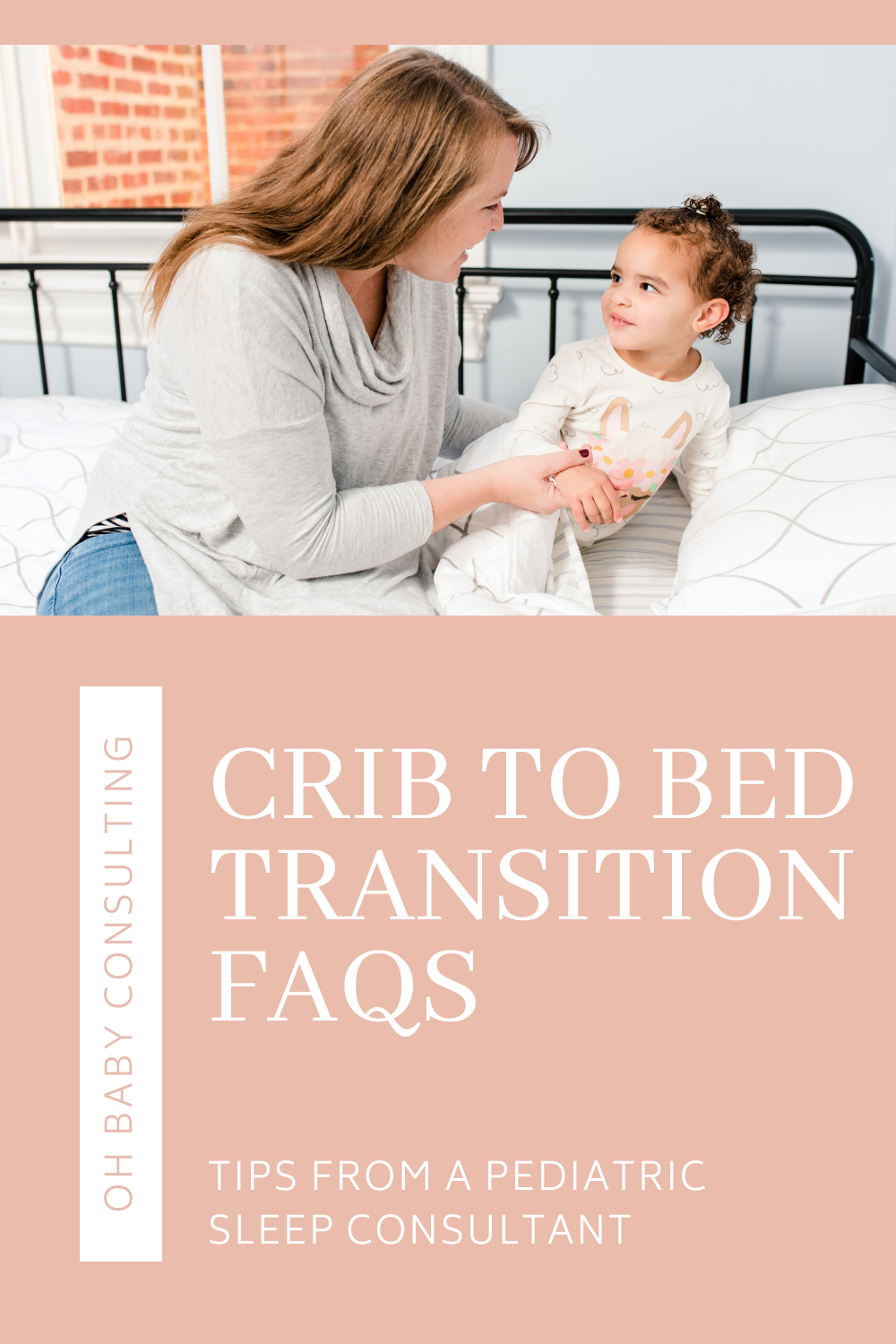Crib to Bed Transition FAQs
The transition from crib to bed is a big move for both child & parent. Literally overnight, your child becomes a little less BABY and a little more BIG KID. I’ve put together the most frequently asked questions I get in my email inbox & on Instagram about this transition and am answering them all in one place today!
What is the best age to transition?
While every child is different in terms of their maturation and development, I usually recommend trying to wait until your child is close to or older than age three. Younger toddlers typically don’t have the cognitive maturity or impulse control to stay in their bed without the physical boundaries of a crib.
Have a crib climber? Check out this post to extend the life of your crib and keep your child sleeping in it safely for a little while longer.
Beyond age, you want to make sure there are no other major life changes or big events on the horizon. Starting school, a new sibling, moving homes, vacations, potty training – these are all things that should be separated from this transition by 3-4 months if possible.
We have a new baby on the way and don’t want to buy another crib. Can we switch early?
I wouldn’t. New baby will likely be in a bassinet for the first 4-5 months and then, if needed, you can transition them to a play yard like the Pack ‘n Play to buy you some more time.
If my child is potty trained/potty training, should they be out of the crib?
Potty training before age 3 would not be a reason to move your child from a crib to a bed. Most toddlers are daytime potty trained well before they are nighttime potty trained anyway, and the majority of toddlers will just go in their diaper or pull-up while they are sleeping (meaning their baldder muscles are not yet strong enough to make it through the night).
If your child is waking up and asking to go potty in the middle of the night, you can let them know that they can go in their diaper or pull-up; for the majority of toddlers, this is not confusing and does not derail daytime potty training.
For more on nighttime potty training, check out this Instagram post.
Our crib converts to a toddler bed. Should we go that route or buy a new bed?
A lot of parents like to go the “toddler bed” route because they assume their child is going to be more likely to stay put since it looks almost like their crib. Honestly, this is rarely the case. In fact, I’ve found that taking the side off the crib actually draws more attention to the fact that your child can now get up and out of bed. Additionally, with a bed so close to the ground, it’s also physically easier for your child to leave their bed. While I’m not saying you need to buy a bunk bed & put them on the top bunk (definitely not safe!) there is something to be said for putting them in a twin or full-size bed which is less of an invitation for them to get out. Plus, it’s one less transition later on!
Should I use a bed rail?
You can! You can also cut up pool noodles and put them under the fitted sheet as an alternative to purchasing bed rails.
Should we do a slow transition (i.e. naps first)?
I don’t recommend this. I find that toddlers really operate in the black & white more than we do as adults and don’t appreciate the small goals as much. It can become confusing to them if you’re doing certain things on certain days and then changing it up. Instead, helping them adjust to their “new normal” all at once is the way to go.
What should we do to prep?
First, you’re going to want to make sure your child’s sleep space is safe for them now that they could get out of bed & roam their room. Here’s a quick checklist to get you started:
- Furniture is anchored to the walls
- Large & heavy objects are removed from shelves
- Electrical cords are safely secured in a cable runway or out of reach behind an anchored piece of furniture
- All electrical outlets are covered
- There are no blind cords/any blind cords are wound up & out of reach
- Windows are not able to be opened more than 4 inches
- Small toys/choking hazards are removed from the room
Then, get your child involved in the transition! Shop for beds, bedding, nightstands, a new lovey – things that can make them excited about the change in a positive way.
Plan to put the new bed the same place that you had their crib (if possible) and change very little else about the bedroom. It’s important that your child still sees their sleep space as a recognizable, safe place.
Beyond that, there’s no need to make a huge deal about the transition. This can create anxiety in some children. While you can prep them a couple days in advance and certainly have them help set up the room, when it comes time for bedtime, plan on doing your normal bedtime routine just instead of getting them in their crib, you’ll be tucking them into their cozy new bed.
How do I get my child to stay in bed without laying with them?
This is a struggle that most toddler families run into at some point or another. Even children who were sleep trained as babies can evolve into toddlers who require a parent’s presence while falling asleep (and sometimes again in the middle of the night). It’s totally normal to have to reset boundaries now that your child has a different sleep set-up.
If you’re making this transition and you’re not already involved in your child’s falling asleep process, don’t start now! At the end of your normal bedtime routine, tuck them into bed & leave the room just like always. Don’t plant any type of seed that they can get out! And definitely avoid starting a new habit altogether by laying there with them as they fall asleep. If they get out of bed to test their new boundaries, you’ll have to return them back to bed each time. Eventually, they’ll get the memo.
If you’re currently struggling with this, then let’s connect and get a plan & support in place for you.
What do I do if my child keeps getting out of bed?
If your child is falling asleep independently at bedtime, they already have the confidence and ability to sleep on their own, they just need a reminder that the boundaries are still the same in the middle of the night. Walk them back to bed and make any interaction as boring as possible. If sleeping in your bed, having you lay with them, or getting something else in the middle of the night is an option (even inconsistently), they will keep waking and looking for that thing. Consistency matters here, so even if you have to walk them back 50 times, you must hold this boundary.
Toddler sleep disruptions can be incredibly nuanced. If you’re currently struggling with this, then let’s connect and get a plan & support in place for you.
My child appears at my bedside at 5:00 a.m. thinking it’s time to get up! How can I stop this?
When you transition your child to a bed (or ideally before), you can introduce a Toddler Clock. A Toddler Clock is a tool you can use to help your child understand the boundaries of when it’s time to stay in bed and when it’s okay to get up.
For more information on how to use a toddler clock, check out this post.
My favorite toddler clocks include:
Little Hippo Mella Ready to Rise
Of course you’ll also want to look at your child’s schedule and make sure it’s appropriate (nap is not too early/late/long) as well as other early morning culprits.
[I independently source and vet any products that I choose to share on my site. If you buy from the links I’ve provided, I may receive a small commission, which in turn supports my work.]
One final tip: There is sometimes a honeymoon period where toddlers are awesome sleepers for 3-4 weeks and then the wheels come off. Maintaining a consistent bedtime routine, holding firm to your boundaries, and responding swiftly to any pushback can help keep things from getting derailed. But know that if you run into any struggles, I’m here to help!
If you’re exhausted, totally overwhelmed by your child’s sleep habits, or looking for answers to the sleep questions that keep you up at night (literally), then you’ve come to the right place. I’m Jamie, founder of Oh Baby Consulting, and my goal is to help your family get the sleep you need to not just survive, but thrive!

